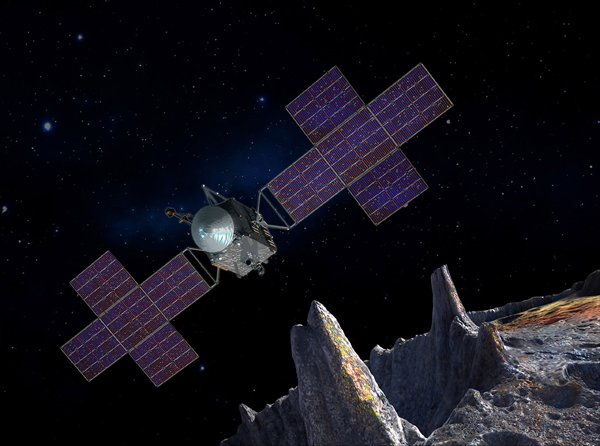The mission to asteroid 16 Psyche just had its launch date pushed up — and will now arrive well before originally planned.

SSL/ASU/P. Rubin/NASA/JPL-Caltech
NASA JPL recently announced that the Psyche mission, originally slated to launch in 2023, will start its journey a year earlier, in the summer of 2022.
The decision comes as a result of an new, optimized trajectory that doesn’t require an Earth gravity assist — and arrives a whopping four years earlier, in 2026! The new trajectory also stays farther from the Sun, meaning it needs less heat protection. And it costs less too
The new trajectory does, however, require more power, a challenge that the team building Psyche at Space Systems Loral (SSL) in Palo Alto, California, took on with gusto. The spacecraft will now have a five-panel x-shape solar array instead of the original four-panel design. This larger array, combined with Psyche’s relatively small size, will power the speeds needed to achieve the new trajectory.
The Psyche mission was chosen back in January as part of NASA’s Discovery Program along with a second mission, Lucy, which launches in 2021 to study six of Jupiter’s Trojan asteroids. Psyche in turn will travel to one of the largest asteroids in the asteroid belt, 16 Psyche.
Discovered by Italian astronomer Annibale de Gasparis in 1852, and named for the Greek goddess of the soul, 16 Pysche was the 16th asteroid to be detected. It’s an interesting object to visit because of its composition — 16 Psyche is a metal world made almost entirely of nickel and iron. The lack of rock has led researchers to suspect that it might be the exposed core of a protoplanet.
In the early formation of the solar system, planetesimals often collided, forming larger bodies or breaking apart into smaller pieces. 16 Psyche may once have been the core of such a planetesimal, whose mantles and crust were blasted or shorn off in a cosmic collision. If it is, observations could serve as a window into Earth’s center.
The Psyche spacecraft houses a payload of magnetometers, multispectral images, and a gamma ray and neutron spectrometer, all of which will help determine whether 16 Psyche is indeed the core of an unsuccessful planet and whether it formed similarly to the Earth’s core. We should also get stunning views of the strange asteroid’s surface.
No matter what we learn when Psyche arrives, this journey to a metal world just got a serious speed upgrade.
You can read more in the press release from JPL.
 0
0









Comments
You must be logged in to post a comment.